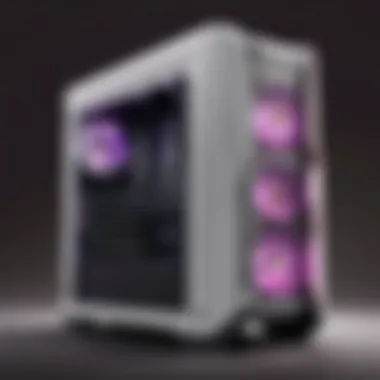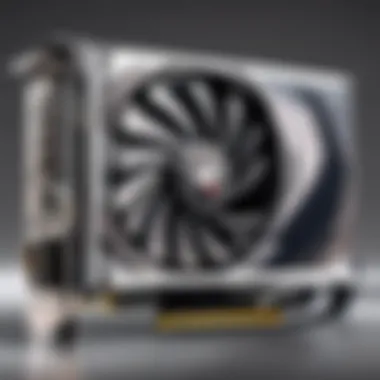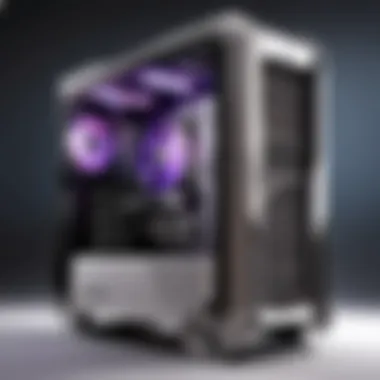Essential Minimum Specifications for Optimal Gaming PC Performance


Gaming PC Minimum Specifications
Are you passionate about gaming, seeking to elevate your experience to new heights? The standout component, the cornerstone of your gaming journey, hinges crucially on your PC's specifications. Let's delve deep into the fundamental criteria that you must consider when aiming for optimal performance and seamless gameplay on your gaming PC.
From the very heart of the technical realm, your gaming PC is a convergence of hardware excellence. Envision a realm where processing power, graphics capability, and system memory orchestrate a symphony of gaming prowess. To steer you towards this technological utopia, we meticulously dissect the essential components that form the bedrock of your gaming rig.
Why Components Matter
The central allure of an adept gaming PC rests on the harmonious symbiosis of its components. Picture a finely tuned engine in a high-performance car; each part serves a distinct yet integral role in propelling you towards gaming nirvana. Processors, graphic cards, memory modules – these are not mere gadgets but the lifeblood coursing through the veins of your digital battlefield.
As you venture deeper into the labyrinth of gaming PC specifications, be prepared to navigate a maze of technical terminology. Fear not, for we shall unravel the complexity seamlessly, offering insightful guidance on each component's significance and its impact on your gaming escapades.
Processor: The Brain Behind the Operation
The nucleus of your gaming PC, the processor acts as the calculating maestro, executing commands with unparalleled precision. Many a battle in the virtual realm hinges on the swiftness and efficiency of your CPU's computations. Dive into the realm of clock speeds, core counts, and cache sizes – elements that dictate the processing prowess of your gaming rig.
Within the processor's domain lies an array of options, from the stalwart AMD Ryzen series to the venerable Intel Core processors. With our expert analysis, traverse the landscape of processors, unveiling the gems that promise to elevate your gaming exploits beyond imagination.
Graphics Card: Rendering Realism in Pixels
Behold the visage of your gaming world through the lens of your graphics card, the architect of visual majesty in the virtual realm. Dive into the ocean of GPU architectures, VRAM capacities, and CUDA cores – elements that breathe life into your gaming landscapes with unrivaled vibrancy.
With a myriad of graphics cards adorning the market, discerning the optimal choice can be a daunting odyssey. Fear not, as we guide you through the realm of NVIDIA's Ge Force series, AMD's Radeon lineup, and the delicate equilibrium between performance and affordability.
System Memory: The Vault of Multitasking
Enter the annals of system memory, a sanctum where instantaneous data access and multitasking prowess converge into a symphony of seamless gaming experiences. Delve into the realms of RAM capacities, clock speeds, and latency timings – aspects that define the pace and agility of your gaming adventures.
In the intricate dance of technology and functionality, strike a delicate balance between memory capacities and speeds to craft a system that transcends mere gaming rigidity. Wander alongside us as we unravel the mysteries of DDR4 modules, SO-DIMM form factors, and memory channels to architect a system that caters to your gaming inclinations with splendid finesse.
In Closing
As you venture forth into the realm of gaming PC specifications, armed with newfound knowledge and insights, the path to an unparalleled gaming experience unfolds before you. Equip yourself with the wisdom ingrained within these fundamental criteria, sculpting a gaming rig that not only meets but surpasses your expectations of digital grandeur. Embrace the synergy of components, unlock the potential of processing power, and immerse yourself in the visual tapestry woven by a stellar graphics card. Your gaming odyssey awaits – seize it with fortitude and embark on a journey where gaming transcends mere recreation to become an art form of technological marvel.
Understanding the Basics
When delving into the realm of gaming PCs, understanding the basics becomes paramount. The foundation upon which the entire system is built, the processor (CPU), graphics card (GPU), memory (RAM), storage, motherboard, and power supply unit (PSU) collectively dictate the performance and capabilities of your gaming rig. By comprehensively grasping these fundamental components and their intricacies, gamers can make informed decisions, ensuring optimal performance and a seamless gaming experience every time they power up their system.
Processor (CPU)
Core Count
Core count stands as a pivotal aspect in the realm of Central Processing Units (CPUs). This metric signifies the number of independent processing units within the CPU, with higher core counts equating to enhanced multitasking abilities and overall processing power. Gamers benefit significantly from CPUs with higher core counts, especially in modern gaming scenarios that demand multitasking capabilities for seamless gameplay, live streaming, and content creation. While a higher core count empowers the CPU to handle concurrent tasks efficiently, it's essential to balance this with other factors to optimize performance and cost-effectiveness for a gaming PC.


Clock Speed
Clock speed denotes how quickly the CPU can execute instructions, measured in gigahertz (GHz). A higher clock speed translates to faster processing, enabling quicker loading times, smoother gameplay, and improved overall system responsiveness. Gamers seeking a more responsive gaming experience and better frame rates may opt for CPUs with higher clock speeds, but it's vital to consider the balance between clock speed, core count, and budget to achieve an optimal gaming setup.
Cache
The CPU cache plays a crucial role in storing frequently accessed data for rapid retrieval, minimizing latency and enhancing system performance. With varying cache sizes across CPU models, a larger cache size often results in improved task responsiveness and smoother multitasking capabilities. Gamers looking to elevate their gaming experience may prioritize CPUs with ample cache sizes to bolster performance in resource-intensive games and demanding applications effectively.
Graphics Card (GPU)
GPU Memory
GPU memory, also known as Video Random-Access Memory (VRAM), directly impacts a gaming PC's graphical performance and ability to handle complex visuals. A higher VRAM capacity allows the GPU to store more textures, shaders, and frame buffers, crucial for rendering detailed graphics seamlessly. Gamers aspiring for immersive gaming experiences and smooth frame rates often opt for GPUs with generous VRAM allocations to accommodate modern game titles and graphics-intensive applications effectively.
CUDA Cores
CUDA (Compute Unified Device Architecture) cores serve as parallel processors within NVIDIA GPUs, facilitating accelerated processing for compute-intensive tasks like gaming, rendering, and artificial intelligence applications. The number of CUDA cores directly influences the GPU's performance in handling complex calculations and graphical workloads efficiently, making it a notable consideration for gamers seeking enhanced computational capabilities and seamless gaming performance.
Ray Tracing Capability
Ray tracing, a cutting-edge rendering technique, simulates the behavior of light in virtual environments to deliver realistic reflections, shadows, and lighting effects in games. GPUs equipped with ray tracing capability leverage specialized hardware to enhance visual fidelity and immersion, setting new standards for graphical quality and realism in gaming. Gamers desiring breathtaking visual experiences and next-generation graphics often prioritize GPUs with ray tracing support for unparalleled realism and visual immersion.
Memory (RAM)
Capacity
RAM capacity fundamentally influences a gaming PC's ability to handle multiple tasks simultaneously, store temporary data for running applications, and maintain system responsiveness during gameplay. Higher RAM capacities enable smoother multitasking, faster loading times, and improved performance in memory-intensive games, optimizing the gaming experience for enthusiasts and professional gamers alike.
Speed
RAM speed, measured in megahertz (MHz), determines how quickly data can be accessed and transferred within the system. Faster RAM speeds facilitate quicker data processing, reducing bottlenecks and enhancing overall system performance. Gamers striving for seamless gameplay and faster application launches may prioritize RAM modules with higher speed ratings to minimize latency and optimize their gaming rig's performance.
Dual Channel vs. Single Channel
The memory configuration, whether dual-channel or single-channel, plays a crucial role in maximizing RAM performance and bandwidth. Dual-channel memory setups enable better data transfer rates and improved system stability by leveraging two memory modules simultaneously. Gamers aiming for enhanced memory performance and smoother gameplay often opt for dual-channel configurations to harness the full potential of their RAM modules, resulting in better multitasking capabilities and responsive gaming experiences.
Storage
SSD vs. HDD
The choice between Solid-State Drives (SSDs) and Hard Disk Drives (HDDs) influences a gaming PC's storage performance, speed, and overall responsiveness. SSDs offer significantly faster read and write speeds compared to traditional HDDs, enhancing system boot times, game loading speeds, and responsiveness during gameplay. Gamers seeking swift system boot-ups and reduced loading times frequently prefer SSDs for their gaming rigs to elevate gaming performance and user experience.
Storage Capacity


Storage capacity dictates the amount of data a gaming PC can store, encompassing game installations, media libraries, and system files. Larger storage capacities accommodate extensive game libraries, multimedia content, and software applications, ensuring ample space for future gaming endeavors and content creation pursuits. Gamers with substantial storage requirements often opt for high-capacity drives to cater to their expansive digital collections and diversified computing needs effectively.
Motherboard
Form Factor
The motherboard's form factor influences the overall size, layout, and connectivity options of a gaming PC, defining the system's maximum potential for expansion and component compatibility. Selecting the appropriate form factor aligns with the desired PC case size, cooling system options, and expansion capabilities, ensuring a balanced and optimized gaming setup tailored to specific preferences and requirements. Gamers aiming for seamless component integration, efficient cable management, and future upgrade possibilities prioritize motherboards with suitable form factors to enhance system aesthetics and functionality.
Chipset
The motherboard chipset serves as a critical component coordinating communication between the CPU, RAM, storage devices, and expansion cards, determining system performance, connectivity options, and compatibility with peripheral devices. Different chipsets offer varying features, such as overclocking support, RAID functionality, and specific connectivity standards, catering to diverse user requirements and performance preferences. Gamers seeking robust system performance, efficient data transfers, and versatile connectivity features carefully consider motherboard chipsets to optimize their gaming PC's capabilities and potential for future upgrades.
Power Supply Unit (PSU)
Wattage
The PSU wattage denotes the maximum power output the power supply can deliver to system components, ensuring stable and reliable operation under varying load conditions. Selecting an adequate wattage rating aligns with the total power consumption of the gaming PC components, preventing potential power shortages or inefficiencies that could impact system stability and performance. Gamers building or upgrading their gaming rigs prioritize PSU wattages that exceed the total power requirements of all components, allowing headroom for future upgrades and ensuring optimal power delivery for sustained gaming sessions.
Efficiency Rating
The PSU efficiency rating signifies how effectively the power supply converts AC input power to DC output power, indicating energy conservation and operational efficiency. Higher efficiency ratings, expressed as percentages, reflect reduced power wastage and heat generation, enhancing system reliability, power savings, and environmental sustainability. Gamers conscious of energy consumption, system performance, and long-term cost efficiency opt for PSUs with high efficiency ratings to optimize power utilization, minimize heat output, and promote eco-friendly computing practices for sustainable gaming experiences.
Optimal Configurations
Optimal Configurations in the domain leave us with a critical array of decisions. As we navigate the realm of building a supreme gaming setup, the focus gravitates towards achieving the perfect equilibrium within the architecture. Crucial to the overall gaming experience, these configurations determine the seamless performance and efficiency of our system. Understanding the intricate balance between various components is fundamental in orchestrating a symphony of gaming excellence.
Budget-Friendly Setup
Recommended Components
When delving into the realm of Recommended Components, we unveil the backbone of our gaming rig. These components play a pivotal role in sculpting a setup that harmonizes efficiency with cost-effectiveness. The synergy of these components not only assures optimal performance but also ensures a budget-friendly approach. The beauty of these components lies in their ability to deliver exceptional performance without burdensome costs. They cater to the needs of our setup while maintaining a prudent approach to expenditure.
Performance Expectations
In the realm of Performance Expectations, we set the stage for evaluating the capabilities of our budget-friendly setup. By defining the objectives and benchmarks for performance, we establish a roadmap towards achieving gaming nirvana. These expectations serve as guiding metrics, steering our build in a direction aligned with our desires. Understanding the nuances of performance expectations allows us to cultivate a setup that exceeds traditional boundaries, offering a glimpse into a world of immersive gaming possibilities.
Mid-Range Performance
Balanced Components
Balanced Components define the essence of equilibrium in our gaming configuration. By harmonizing performance with affordability, these components strike a chord between power and cost-effectiveness. The allure of balanced components lies in their ability to cater to a wide spectrum of user demands, catering to both casual gamers and enthusiasts alike. Their versatility ensures a smooth gaming experience while adhering to a pragmatic budget.
Future-Proofing Considerations


Future-Proofing Considerations propel us into the realm of foresight, encapsulating the essence of longevity in our setup. By integrating components that withstand the test of time, we safeguard our investment against rapid technological obsolescence. The strategic integration of future-proofing elements ensures that our gaming rig remains at the pinnacle of performance for years to come, transcending the boundaries of conventional gaming expectations.
High-End Gaming Rig
Top-of-the-Line Components
Top-of-the-Line Components epitomize the pinnacle of gaming excellence, offering unmatched performance and cutting-edge technology. These components redefine the boundaries of gaming capabilities, pushing the limits of what a gaming setup can achieve. Their premium features and superior craftsmanship elevate the gaming experience to unprecedented heights, catering to the needs of discerning gamers who demand nothing but the best.
Overclocking Potential
Delving into Overclocking Potential unravels a realm of endless possibilities for performance optimization. By harnessing the power of overclocking, we unlock hidden potential within our components, squeezing out every ounce of power for enhanced gaming experiences. The allure of overclocking lies in its ability to elevate our setup beyond conventional limits, providing a competitive edge in the realm of gaming prowess. However, prudent consideration of the risks and benefits associated with overclocking is paramount to unleashing its full potential.
Additional Considerations
In this section, we delve into the auxiliary aspects vital for optimizing your gaming PC setup. Additional considerations go beyond mere hardware specifications, encompassing factors that can significantly impact your gaming experience. From cooling solutions to case selection and peripherals, these elements play a crucial role in the overall performance and functionality of your gaming rig. In the competitive gaming realm, every detail counts, making these considerations indispensable for both casual and pro gamers seeking an edge in performance and comfort.
Cooling Solutions
Air Cooling vs. Liquid Cooling
When pondering the cooling solutions for your gaming PC, the dichotomy between air cooling and liquid cooling stands as a critical decision point. Air cooling relies on air circulation through heat sinks and fans, offering a straightforward and cost-effective method for dissipating heat. On the other hand, liquid cooling utilizes coolant to absorb and dissipate heat more efficiently, often favored by enthusiasts for its superior thermal performance. The advantage of air cooling lies in its simplicity and widespread compatibility, catering to a broader range of build setups. Conversely, liquid cooling boasts enhanced cooling capabilities, ideal for high-end systems requiring efficient heat dissipation.
Cooling Performance
Cooling performance is paramount for maintaining optimal system temperatures under heavy gaming loads. The efficacy of your cooling system directly impacts the longevity and performance of your components, safeguarding against overheating and potential hardware malfunctions. Efficient cooling solutions not only ensure consistent performance but also contribute to a quieter and more stable gaming environment. Balancing thermal management with noise levels is key, striking a harmonious equilibrium between cooling efficiency and acoustic comfort for a seamless gaming experience.
Case Selection
In the realm of case selection, aesthetics and functionality converge to influence the overall appeal and practicality of your gaming setup. The aesthetic aspects of a PC case extend beyond mere visual allure, encompassing features like RGB lighting, tempered glass panels, and customizable accents that contribute to a personalized gaming aesthetic. While aesthetics play a significant role, functional considerations such as airflow optimization and component clearance are equally crucial. A well-designed case not only enhances the visual aesthetics of your rig but also ensures proper ventilation and component accessibility, optimizing performance and longevity.
Aesthetics
The aesthetic appeal of your gaming rig reflects your personal style and sets the tone for your gaming environment. Whether you prefer a sleek and minimalist design or a bold, eye-catching aesthetic, the choice of case aesthetics can elevate the overall presentation of your setup. Aesthetically pleasing cases not only enhance the visual appeal of your gaming station but also contribute to a cohesive and immersive gaming experience, reflecting your individuality and attention to detail.
Airflow Optimization
Airflow optimization within your PC case is paramount for maintaining proper ventilation and thermal performance. Efficient airflow management ensures that components receive an adequate supply of cool air while expelling hot air efficiently. Factors such as fan placement, cable management, and case design significantly influence airflow dynamics, directly impacting the cooling efficiency and overall temperature regulation within your system. By optimizing airflow patterns and implementing strategic cooling strategies, you can enhance the thermal performance and longevity of your components, ensuring a stable and responsive gaming experience.
Peripherals
The peripheral devices accompanying your gaming PC play a pivotal role in shaping your gaming experience, influencing comfort, precision, and immersion. Monitor specifications, keyboard, and mouse preferences directly impact your interaction with games, offering customization options tailored to your gameplay style. From high-refresh-rate monitors for fluid visual performance to ergonomic keyboards and precision mice for accurate input control, selecting the right peripherals can enhance your gaming prowess and elevate your competitive edge.
Monitor Specifications
Monitor specifications encompass essential features such as resolution, refresh rate, and panel technology, directly impacting the visual fidelity and responsiveness of your gaming experience. High-resolution displays offer crisp visuals and enhanced detail, while high refresh rates ensure smooth gameplay with minimal motion blur. Panel technologies like IPS, TN, and VA provide varying color accuracy and viewing angles, catering to different gaming preferences. Choosing the ideal monitor specifications tailored to your gaming preferences can elevate your visual immersion and responsiveness, enhancing overall gameplay enjoyment.
Keyboard and Mouse Preferences
Your keyboard and mouse preferences are integral to your gaming performance, influencing input precision, comfort, and customization options. Mechanical keyboards offer tactile feedback and customizable key switches, catering to individual typing preferences and gaming styles. Precision gaming mice with adjustable DPI settings, ergonomic designs, and programmable buttons enable enhanced control and responsiveness in-game. Tailoring your keyboard and mouse preferences to suit your gaming habits and comfort preferences can significantly impact your performance and comfort during extended gaming sessions, ensuring seamless input control and gameplay efficiency.



